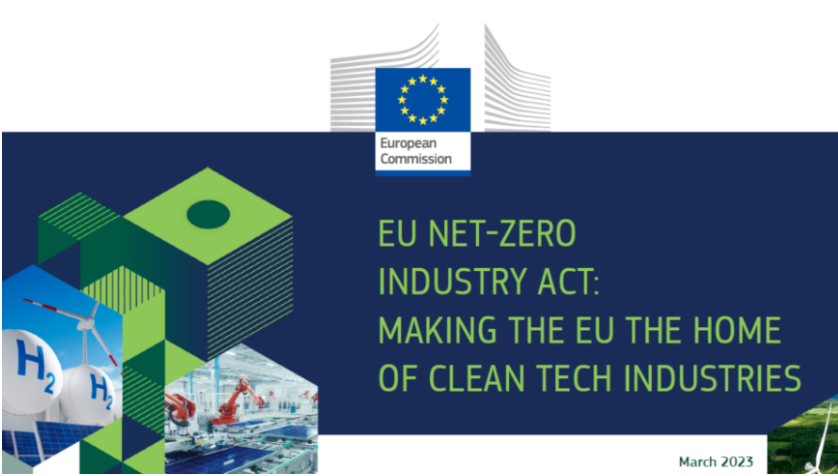
Last month, the European Commission (hereinafter referred to as the Commission) announced the Net Zero Industry Act
Industry Act (hereinafter referred to as the "Act"). This bill is the EU Green Agreement Industrial Plan (The
Part of the Green Deal Industrial Plan. This bill is seen as a response to the EU's green manufacturing subsidy policies for major economies, aimed at enhancing the competitiveness of domestic clean energy manufacturing and reducing dependence on other economies. On the same day, the European Union also issued another key raw material bill, aiming to enhance the supply capacity of local key raw materials. The Key Raw Materials Act proposes that at least 10% of key raw materials are extracted within the EU each year, at least 40% of key raw materials are processed within the EU, and at least 15% of annual raw material consumption comes from renewable extraction. At any stage of processing, the consumption of raw materials from a single country must not exceed 65% The high dependence of the European market on Chinese photovoltaic products has not decreased, but has increased. Market information company Infolink
According to Consulting data, in 2022, Chinese photovoltaic companies exported a total of 154.8GW of photovoltaic modules, an increase of 74% compared to 2021. More than half of the photovoltaic modules are shipped to the European market. In 2022, China exported 86.6GW of photovoltaic modules to Europe, a year-on-year increase of 40.9% compared to 2021
GW has increased by 112%, and Europe has become the largest export destination for China's photovoltaic module products. From the perspective of enterprises, as it is currently in the early stages of policy, there have been no substantive response actions yet. Firstly, the benchmark of the Net Zero Industries Act is mainly the Inflation Reduction Act (IRA) of the United States, which is aimed at manufacturing industry return (Europe and America). However, generally speaking, EU level bills may not be implemented in the next 1-2 years, even considering factors such as the change of the European Commission, and may not be implemented for a long period of time. In addition, the 65% restriction in the bill may have certain benefits for Chinese photovoltaic companies with overseas production capacity, including those with production capacity in Southeast Asia. The fundamental purpose of the EU's policy is not to restrict China, but to benchmark the US Inflation Reduction Act (IRA). If the EU does not do so, their local enterprises' factory construction, including manufacturing capacity, will 'run' to other countries, so the fundamental purpose of introducing policies can be understood as to ensure that local manufacturing is not 'taken' away What areas of enterprises will the bill affect? The Net Zero Industry Act targets Chinese companies in the green sector that have already, are, or will gain absolute or significant advantages in the European market in the future. This includes the first category, which has a market share of over 90% in Europe. Europe believes that there is a serious dependence on China in areas such as photovoltaic upstream product casting and wafers
wafers); Or green cutting-edge areas where Chinese/Asian companies have manufacturing advantages, such as batteries and electric vehicles. In the second category, the EU once had technological or market advantages, but in recent years it has been losing its domestic market in areas such as heat pump products that have gone from a surplus to a deficit with China in recent years
pumps)。 The third category is still being developed, but the EU is concerned about new technologies that China is leading, such as carbon capture, utilization, and storage technology (Carbon
Capture, Utilization and. Storage, etc. | The impact of the bill on China's photovoltaic industry exports will take some time to release. According to data disclosed by the China Photovoltaic Industry Association, silicon wafers and battery products are mainly exported to the Asian region, while the European region mainly exports components. In 2022, the proportion of photovoltaic module exports from China to the European market increased to 54.8%, an increase of 10.9 percentage points compared to 2021. Among them, the Netherlands maintains its position as the largest export market for components in China, accounting for up to 26.7%. It is undeniable that the strong market demand has made the European market the largest source of revenue for many domestic photovoltaic companies' overseas business in recent years. However, the frequent emergence of trade barriers also brings great uncertainty to China's photovoltaic enterprises in expanding overseas markets. The bill mainly targets public bidding projects, but currently public contracts only account for a small portion of European demand, especially after the rise in electricity prices in Europe last year, the prices of market-oriented projects are more attractive than government public bidding projects, resulting in a higher degree of marketization of photovoltaic in Europe last year, so the scope of the bill's impact is relatively limited. At present, the bill is still in the draft stage and will go through a lengthy voting and deliberation process, as well as obtaining the consent of member states before it can be established. Therefore, the short-term impact is not significant. Moreover, there are concerns within the EU that the bill may violate international trade laws, resulting in significant uncertainty.





